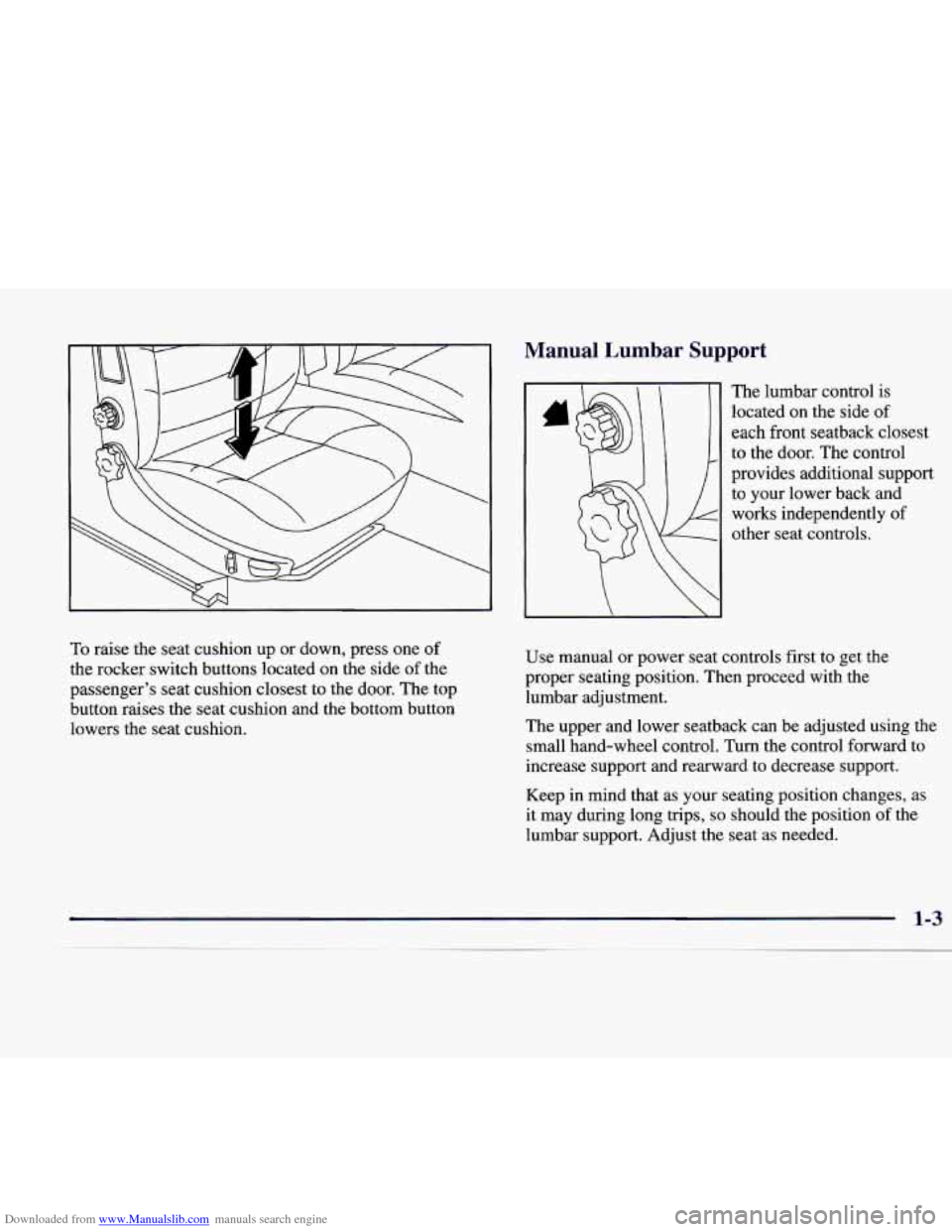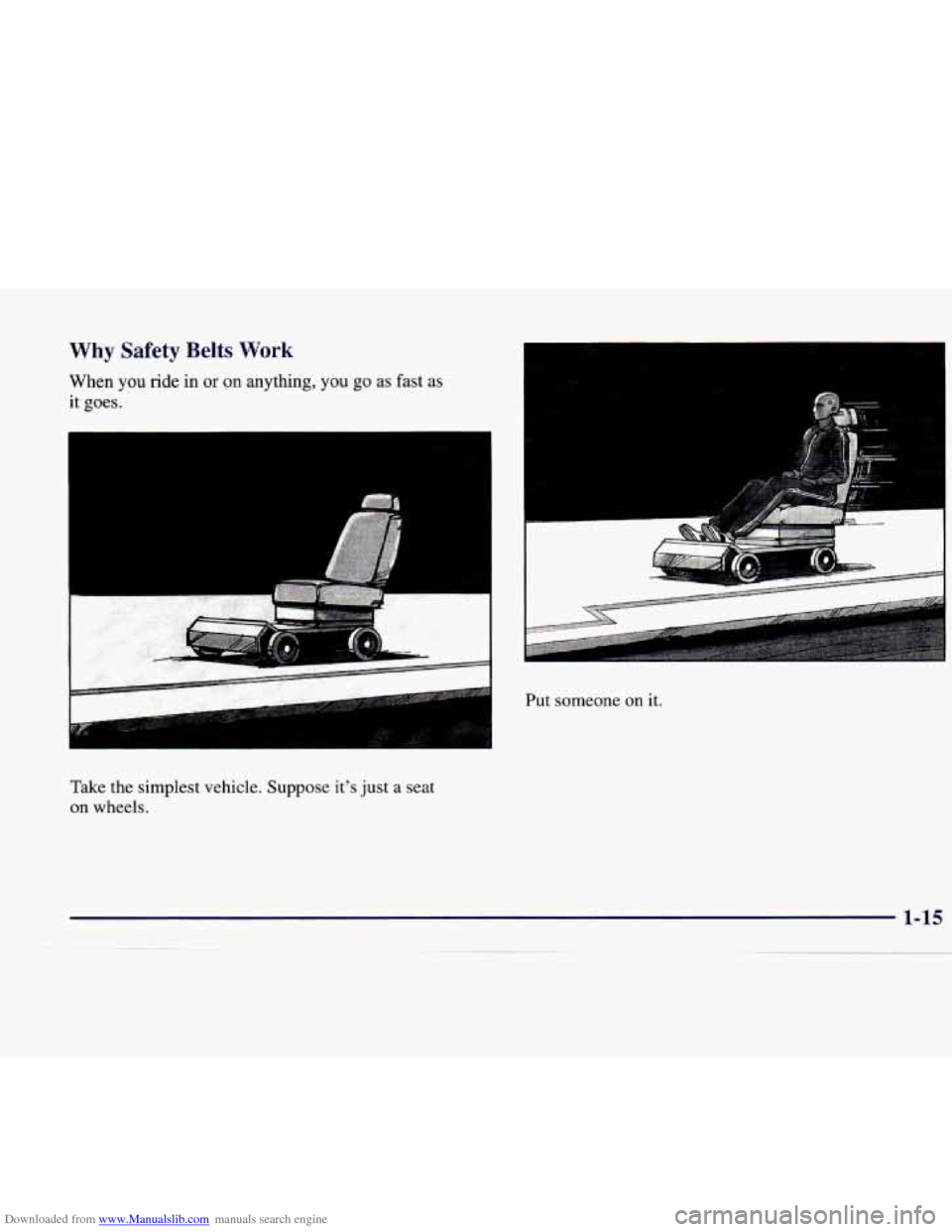1998 CADILLAC CATERA wheel
[x] Cancel search: wheelPage 16 of 346

Downloaded from www.Manualslib.com manuals search engine 10 raise the seat cushion up or down, press one of
the rocker switch buttons located on the side of the
passenger’s seat cushion closest to the door. The top
button raises the seat cushion and the bottom button
lowers the seat cushion.
Manual Lumbar Support
The lumbar control is
located on the side
of
each front seatback closest
to the door. The control
provides additional support to your lower back and
works independently
of
other seat controls.
Use manual or power seat controls first to get the
proper seating position. Then proceed with the
lumbar adjustment.
The upper and lower seatback can be adjusted using the
small hand-wheel control. Turn the control forward to
increase support and rearward to decrease support.
Keep
in mind that as your seating position changes, as
it may during long trips, so should the position of the
lumbar support. Adjust the seat as needed.
Page 19 of 346

Downloaded from www.Manualslib.com manuals search engine Heated Front Seat (Option)
‘1
The controls are located
next to the radio on the
center console. Press this
button to turn on the heating
element in the seat. The
seatback and cushion are
warmed until they match
your body temperature.
A telltale light in the button reminds you that the heating
system is in use. The heated seats can only be used when
the ignition
is turned on.
Reclining Front Seatbacks
This feature is found on
the passenger’s seat only.
The manual recliner control
is located on the side
of
the passenger’s seatback
closest to the door, below
the lumbar control. See
“Manual Lumbar
Support’’
earlier in this section.
To move the seatback forward, turn the hand-wheel
control forward. Turn the control rearward to recline the seatback.
If
you have cloth seats, and if you want to fold the
seatback all the way down to provide extra storage, see
“Passenger Seatback Latch” later in this section.
Page 28 of 346

Downloaded from www.Manualslib.com manuals search engine Why Safety Belts Work
When you ride in or on anything, you go as fast as
it goes.
Take the simplest vehicle. Suppose it's just
a seat
on wheels.
I
Put someone on it.
Page 43 of 346

Downloaded from www.Manualslib.com manuals search engine I There is an air bag
readiness light on-the
instrument panel, which
shows the air bag symbol.
The system checks the
air bag electrical system for
malfunctions. The light tells you if there
is an electrical
problem. See “Air Bag Readiness Light” in
the Index
for more information.
How the Air Bag Systems Work
Where are the air bags?
The driver’s frontal air bag is in the middle of the
steering wheel.
1-30
Page 45 of 346

Downloaded from www.Manualslib.com manuals search engine If something is between an occupant and an air
bag, the bag might not inflate properly or it
might force the object into that person. The path
of an inflating air bag must be kept clear. Don’t
put anything between an occupant and an air
bag, and don’t attach or put anything on the
steering wheel hub or on or near any other air
bag covering and don’t let seat covers block the
inflation path of a side impact air bag. When should
an air bag inflate?
The driver’s and right front passenger’s frontal air bags
are designed to inflate in moderate to severe frontal or
near-frontal crashes. The frontal air bags are designed to
inflate only if the impact speed is above the system’s
designed “threshold level.” If your vehicle goes straight
into a wall that doesn’t move or deform, the threshold
level
is about 9 to 15 mph (14 to 24 km/h). The
threshold level can vary, however, with specific vehicle
design,
so that it can be somewhat above or below this
range.
If your vehicle strikes something that will move
or deform, such as a parked car, the threshold level
will be higher. The driver’s and right front passenger’s
frontal air bags are not designed to inflate in rollovers,
side impacts, or rear impacts, because inflation would
not help
the occupant.
Page 46 of 346

Downloaded from www.Manualslib.com manuals search engine The driver’s and right front passenger’s side impact air
bags are designed to inflate in moderate to severe side
crashes involving a front door.
A side impact air bag
will inflate if the crash severity is above the system’s
designed “threshold level.” The threshold
level can
vary with specific vehicle design. Side impact air bags
are not designed to inflate in frontal or near-frontal
impacts, rollovers or rear impacts, because inflation
would not help the occupant.
A side impact air bag will
only deploy on the side of the vehicle that is struck.
In any particular crash, no one can say whether an air
bag should have inflated simply because of the damage
to a vehicle or because of what the repair costs were.
For frontal air bags, inflation is determined by the angle
of the impact and how quickly the vehicle slows down
in frontal and near-frontal impacts. For side impact air
bags, inflation is determined by the location of the
impact and how quickly the side of the vehicle deforms.
What makes an air bag inflate?
In an impact of sufficient severity, the air bag sensing
system detects that the vehicle is in a crash. For both
frontal and side impact air bags, the sensing system
triggers a release of gas from the inflator, which inflates
the air bag. The inflator, air bag and related hardware
are all part of the air bag modules inside the steering
wheel, instrument panel and the side of the front
seatbacks closest to the door.
How does an air bag restrain?
In moderate to severe frontal or near frontal collisions,
even belted occupants can contact the steering wheel or
the instrument panel. In moderate to severe side
collisions, even belted occupants can contact the inside
of the vehicle. The air bag supplements the protection
provided by safety belts.
Air bags distribute the force of
the impact more evenly over the occupant’s upper body,
stopping the occupant more gradually. But the frontal air
bags would not help you in many types of collisions,
including rollovers, rear impacts, and side impacts,
primarily because an occupant’s motion is not toward
the air bag. Side impact air bags would not help you in
many types of collisions, including frontal or near
frontal collisions, rollovers, and rear impacts, primarily
because an occupant’s motion is not toward those air
bags. Air bags should never be regarded
as anything
more than a supplement to safety belts, and then only in
moderate
to severe frontal or near-frontal collisions for
the driver’s and right front passenger’s frontal air bags,
and only in moderate to severe side collisions for the
driver’s and right front passenger’s side impact air bags.
Page 47 of 346

Downloaded from www.Manualslib.com manuals search engine What will you see after an air bag inflates?
After an air bag inflates, it quickly deflates,
so quickly
that some people may not even realize the air bag
inflated. Some components of the air bag module
-- the
steering wheel hub for the driver’s air bag, the
instrument panel for the right front passenger’s bag, the
side of the seatback closest
to the door for the driver and
right front passenger’s side impact air bags
-- will be
hot for a short time. The parts of the bag that come into
contact with you may be warm, but not too hot to touch.
There will be some smoke and dust coming from the
vents in the deflated air bags. Air bag inflation doesn’t
prevent
the driver from seeing or being able to steer the
vehicle, nor does it stop people from leaving the vehicle. When an air bag
inflates, there is dust in the
air.
This dust could cause breathing problems for
people with
a history of asthma or other
breathing trouble.
To avoid this, everyone in the
vehicle should get out as soon
as it is safe to do so.
If you have breathing problems but can’t get out
of the vehicle after an
air bag inflates, then get
fresh air by opening a window or a
door.
I
In many crashes severe enough to inflate an air bag,
windshields are broken by vehicle deformation.
Additional windshield breakage may also occur
from the
right front passenger air bag.
Air bags are designed to inflate only once. After an
air bag inflates, you’ll need some new parts for your
air bag system. If
you don’t get them, the air bag
system won’t be there to help protect you in another
crash.
A new system will include air bag modules
and possibly other parts. The service manual for your
vehicle covers the need to replace other parts.
Page 48 of 346

Downloaded from www.Manualslib.com manuals search engine 0
0
Your vehicle is equipped with a crash sensing and
diagnostic module, which records information about
the frontal air bag system. The module records
information about the readiness
of the system,
when the sensors are activated and driver’s safety
belt usage at deployment.
Let only qualified technicians work on your air
bag systems. Improper service
can mean that an
air bag system won’t work properly. See your dealer
for service.
NOTICE:
If you damage the covering for the driver’s or
the right front passenger’s
air bag, or the air
bag covering on the driver’s and right front
passenger’s seatback, the bag may not work
properly. You may have
to replace the air bag
module in the steering wheel, both the air bag
module and the instrument panel for the right
front passenger’s air bag, or both the
air bag
module and seatback for the driver’s and right
front passenger’s side impact air bag.
Do not
open or break the
air bag coverings. Servicing
Your
Air Bag-Equipped Vehicle
Air bags affect how your vehicle should be serviced.
There are parts of the air bag systems in several places
around your vehicle. Your dealer and the Catera Service
Manual have information about servicing your vehicle
and the air bag systems.
To purchase a service manual,
see “Service and Owner Publications” in the Index.
I
For up to 10 seconds after the ignition key is
turned off and the battery is disconnected, an
air bag can still inflate during improper service.
You can be injured if you are close
to an air bag
when it inflates. Avoid wires wrapped with yellow
felt, wires wrapped with yellow tape or yellow
connectors. They are probably part of the air
bag systems. Be sure to follow proper service
procedures, and make sure the person
performing work for you
is qualified to do so.
The air bag systems do not need regular maintenance.
1-35
.- . -